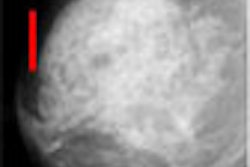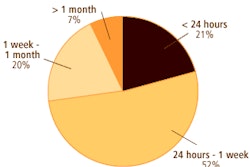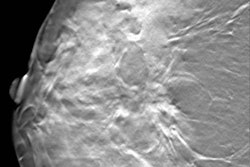
Fujifilm Medical Systems USA announced today that the U.S. Food and Drug Administration has given final approval to its premarket approval (PMA) application for a full-field digital mammography (FFDM) system based on computed radiography (CR) technology. The approval gives breast imaging facilities a new option for going digital that should prove to be more economical than FFDM systems currently on the market.
For many breast imaging facilities, the move to digital mammography has proved to be a challenge. Cost concerns have prevented many centers from installing flat panel-based digital mammography systems, despite recent clinical studies indicating that going digital could have clinical benefits for some types of patients.
But CR mammography could change the equation for U.S. breast centers. The technology will allow sites with existing analog mammography devices to convert to digital with a simple detector switch, making the move to digital more cost-effective in the era of low screening reimbursement rates and high malpractice insurance costs.
Fuji's 510(k) announcement today covers the FCRm system, for which it received an approvable letter from the FDA in May. The company will offer FCRm in both 18 x 24-cm and 24 x 30-cm fields-of-view, and the system boasts 50-micron pixel spot size, providing 10 pixels/mm or 20 pixels/mm spatial resolution, as well as the company's proprietary dual-side reading technology.
The beauty of the device is that rather than having to replace existing mammography equipment, a facility can go digital with its current mammography generator stand just by installing Fuji's dual-side reading FCR reader and an Image and Information Processor (IIP) technologist console, according to Fuji's national program manager of women's health imaging systems, Andrew Vandergrift. Then film cassettes are replaced with FCR cassettes that use imaging plates instead of film as the detector.
And not only can one FCRm convert three screening exam rooms to digital at about half the cost per room as other systems, according to Vandergrift, but the reader can continue to be used for general radiography equipment that has been outfitted with CR imaging plates. This makes the suite very flexible, he said.
Fuji believes the approval will be a watershed moment for the digital mammography market, Vandergrift said.
"The versatility and cost-effectiveness of CR mammography is going to be something that really enables digital in the marketplace," he said. "The share of digital today is going to increase dramatically because of our introduction."
In marketing its CR mammography units, the vendor will be emphasizing the versatility of its offerings, which can address the entire mammography market via a single-plate reader or a multiplate reader approach, Vandergrift said. Fuji will also highlight the benefits of integrating the technology with its Synapse PACS network, said Bob Cooke, director of marketing and product management.
Existing users of the company's ClearView CR readers will also be able to upgrade to digital mammography capability following a software upgrade and the addition of some new cassettes, Cooke said. Pricing for the upgrade is dependent on user configuration.
Outside of the U.S., Fuji has placed more than 2,800 FCRm units; in the rest of the world, the company's single-side CR readers have been used for mammography for diagnostic purposes for more than 10 years, and its double-sided FCRm has been available for two years, Vandergrift said. Fuji has also received approval to market the system in Canada.
But bringing CR mammography to the U.S. market has required a fair amount of patience. Fuji was required to apply for approval under a PMA rather than the less rigorous 510(k) process, and was therefore required to submit clinical data on the use of the system. Fuji took a different approach by applying for the PMA on the software portion of the device, rather than the whole system (since the company's CR readers have long been cleared). Fuji conducted clinical trials at two sites, and four facilities participated in blinded readings.
How does CR mammography stack up?
Because of its later arrival on the market, CR mammography has a shorter track record in clinical studies compared to FFDM. Some of the clinical evidence for CR mammography has been mixed: One study, conducted in 2003 by Dr. Jeffrey Quam of the Rochester, MN-based Mayo Clinic with Fuji's FCRm, showed that computed radiography for breast imaging offers a greater level of lesion conspicuity than film-screen mammography, a feature that is of particular value in imaging dense breast tissue.
But another study, presented earlier that year by researchers at the University of Vienna, using Fuji FCR 5000MA storage-phosphor plates, found advantages to a flat-panel digital mammography device versus a CR-based digital mammography unit. CR performed well in the category of image blackness, but the flat-panel system outperformed in all other categories.
Yet at 50 microns, FCRm has an edge in spatial resolution compared to flat-panel full-field devices on the market: GE's Senographe comes in at 100 microns and Hologic's Selenia at 70 microns. And Fuji's FCRm was used in the Digital Mammographic Imaging Screening Trial (DMIST), which included more than 10,000 studies at seven sites, establishing that its quality is approximately equivalent to that of other approved FFDM systems, according to Dr. Etta Pisano, principal investigator for DMIST and Kenan professor of radiology and biomedical engineering at the University of North Carolina (UNC), Chapel Hill.
"At UNC we used Fuji CR in DMIST and found that it performed equivalently to film in the study, and contributed to the improved diagnostic accuracy we found in women with dense breasts and women under the age of 50," Pisano told AuntMinnie.com.
Assessing the economics
Economically, CR for mammography seems a good fit for low-volume sites, according to Jerry Kolb, founder of Breast Health Management in Plano, TX, and chief development officer of Women's Diagnostic of Dallas/Ft. Worth.
"Sixty-seven percent of the MQSA-certified facilities in the U.S. have one film mammography unit," Kolb said. "Obviously, these are not high-volume situations. There's no question in my mind that over half of the mammography imaging sites in this country have such low volumes that they can't justify a flat-panel digital unit based on their throughput. These are the kinds of sites that stand to benefit directly from this technology."
As for workflow, CR mammography developers believe it will be at least the same as film-screen: Instead of taking a film cassette and putting it into a chemical processor, users will take a digital cassette and put it into the CR reader, which will process it into a digital image on the monitor. The simplicity of the change may appeal to clinical staff wary of the additional training required to operate flat-panel digital mammography devices, according to Kolb.
Fuji believes that CR mammography will improve workflow efficiency over film-screen.
"FCRm's workflow will depend on whether a multicassette reader is used over several mammography rooms, or whether a single-plate reader is used per room. Both have significant benefits over film-based mammography," Vandergrift told AuntMinnie.com. "The dedicated-reader-per-room scenario will have workflow essentially equivalent to DR."
Finally, CR mammography's compactness offers another potential benefit: It can be incorporated into mobile CR units, both in-hospital (as in the single-plate reader scenario above) and out. With a CR mammography van roaming rural areas of the U.S., the quality and accessibility of mammography screening for rural women would increase.
More to come
Fuji isn't the only imaging vendor that's developing CR mammography, and more systems may soon be arriving on the U.S. market thanks to proposed regulatory changes at the FDA.
On May 23, the Radiological Devices Panel of the FDA's Center for Devices and Radiological Health (CDRH) voted to advise the FDA to change the classification of FFDM devices from Class III, which are subject to review via the PMA process, to Class II, making way for other CR mammography developers to use the 510(k) process for their devices.
Draft guidance for FFDM systems still must be published in the Federal Register, the public given time to comment, and the rule-making process presented in the Code of Federal Regulations, all of which can take a year or longer to be completed, according to Nancy Wersto, executive secretary of the panel. When the reclassification is complete, other CR vendors plan to make their own CR mammography offerings.
Eastman Kodak Health Group of Rochester, NY, has CR mammography units installed in Europe and Asia, and has applied for regulatory approval in the U.S. and Canada, according to Stephen Archer, director of worldwide marketing, mammography solutions at the company. Kodak's CR units are being used in a screening program launched in 2005 in conjunction with the American Cancer Society and the Chinese government called the Million Women Mammography Project, the goal of which is to introduce mammography screening in that country.
Philips Medical Systems of Andover, MA, has been installing its Philips Computed Radiography (PCR) for mammography applications in Europe, Asia, and Australia since the early 1990s, according to Christiane Harms, business team manager for mammography. The company's current flagship system, PCR Eleva CosimaX, incorporates Fuji's high-resolution reader with dual-side reading functionality and Philips' own image processing, called Unique. Philips also offers a PACS viewing workstation dedicated for mammography.
And Agfa HealthCare of Greenville, SC, has also been distributing a CR mammography system outside of North America, and intends to introduce it in the U.S., according to Pat Montgomery, manager of women's care, North America.
CR appears poised to enrich mammography screening options in the U.S. But despite growing enthusiasm for the technology, particularly for low-volume facilities, potential users should take care not to be lulled by its apparent ease of installation, according to Kodak's Archer: Using CR to digitize mammography exams won't be just about buying a reader. Administrators still need to consider all the costs involved in creating a digital environment.
"It's not true that a facility can just go out and buy a CR for mammography and think it's done," he said. "You need a mammography PACS work environment established, such as a digital workstation with 5-megapixel monitors, and preferably a RIS system in place. It's important to take an overall systems view of going digital."
By Kate Madden Yee
AuntMinnie.com contributing writer
July 11, 2006
With additional reporting by AuntMinnie.com staff writer Erik L. Ridley.
Related Reading
Fuji adds to Novation deal, June 8, 2006
Fuji mammo CR gets FDA nod, May 31, 2006
Fuji nets Novation deal, May 9, 2006
Orthocrat, Fuji sign agreement, March 21, 2006
Fuji provides CR for horse show, March 17, 2006
Copyright © 2006 AuntMinnie.com



















